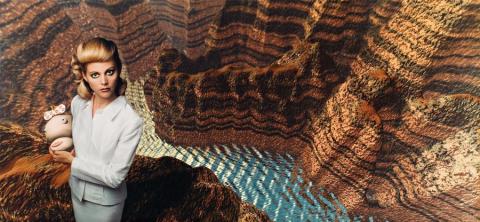PSYCHOTOURISM (FROM THE SERIES 'YOUR TIME STARTS NOW...'), 1996
Patricia Piccinini
Type C photograph
120.0 x 258.0 cm
Tolarno Galleries, Melbourne Private collection, Sydney
Photography is Dead! Long Live Photography!, curated by Linda Michael, Museum of Contemporary Art, Sydney, 23 July – 10 November 1996 (another example)
Patricia Piccinini, Psycho, Tolarno Galleries, Melbourne, 1997 (another example)
The Second Tokyo International Photo-Biennale, Tokyo Metropolitan Museum of Photography, Tokyo, 12 July – 31 August 1997, (illus. in exhibition catalogue p. 115 another example)
Art Gallery of New South Wales, Sydney, CCB Auction, 2004
Charlton, S.,'Art and tech', Artforce, December 1996, pp. 8 & 9 (illus. another example)
Hennessey, P.,'Patricia Piccinini plastic realist', Photofile, December 1997, pp. 22–29
Alexander, G.,'Tableaux – memento mori – screen culture', in Annear, J., Photography: Art Gallery of New South Wales Collection, Art Gallery of New South Wales, Sydney, 2007, pp. 317, 331 (illus. another example)
Other examples from this edition are in the collections of the Art Gallery of New South Wales, Sydney; National Gallery of Victoria, Melbourne; and National Gallery of Australia, Canberra
Selected to represent Australia at the Venice Biennale in 2003, Patricia Piccinini is internationally renowned as one of Australia's most innovative and original artists. From the early cool, custom-made sculptures and elusive photographs to the more recent, all-encompassing installations, her work is always technically awesome. As leading arts theorist Edward Colless observes, 'Piccinini has developed a signature style in digital art and created a striking social statement, alongside a rich personal fantasy, within new media that have otherwise been prone to anonymity.'1
Arguably one of the most acclaimed digital photographs from 'The Mutant Genome Project', initiated by Piccinini to explore issues relating to genetic engineering and 'consumer medicine', Psychotourism 1996 features actress Sophie Lee perched precariously on the edge of a surreal, Martian-like canyon, cradling - as proud owner, mother or older sibling - the curiously unsettling LUMP (Lifeform with Unevolved Mutant Properties). The work also owes much to Australian colonial artist Eugene von Guerard and his images of a land both profoundly alien yet clearly recognisable. As Piccinini elucidates, 'Psychotourism reconfigur[es] his sublime Europeanised-Australia into a majestic yet generic world of computer-simulated landscape LUMP and her protector, both indigenous to the media-landscape, explore their 'natural' habitat, the always recognisable, but never actually visited world of the simulated landscape For me, what is most disturbing about computer-generated landscapes are not how convincing or not they are, but rather how familiar they feel.'2 Blurring the common distinction between ethics and aesthetics, between idea and sensual pleasure, Psychotourism continues the artist's abiding preoccupation with issues of biotechnologies, bioethics and the environment. Attentive to both formal advertising aesthetics of colour, composition and finish, as well as commercially-endorsed ideals of beauty (the glamour of then-starlet Sophie Lee), the work offers the viewer a sensual pleasure inextricably linked to conceptual engagement with the artist's ethical position. As Jacqueline Millner asserts, 'the commercial beauty Piccinini brings to contextualise her digital creatures [such as the LUMP] lends them a certain legitimacy that is underlined by the formal seamlessness between model, creature and virtual landscape. This legitimacy is in effect a kind of beauty by association that allows us to feel well-disposed towards otherwise monstrous hybrids, to deign them with the warm regard we bring to the beautiful'3
In many ways, Piccinini's work seeks to engender love - love in the form of an ethical position towards the products of technology, and particularly biotechnology. Rather than condemn human intervention in life and nature, she suggests that such innovation is not only inevitable, but that its implications are ambiguous - even contradictory - and therefore must be viewed objectively.
1. Edward Colless cited in Australian Art Collector, Issue 19, March 2002, p. 95
2. The artist cited at www.patriciapiccinini.net
3. Millner, J., 'Patricia Piccinini: Ethical Aesthetics' 2001, reproduced at www.patriciapiccinini.net
VERONICA ANGELATOS
